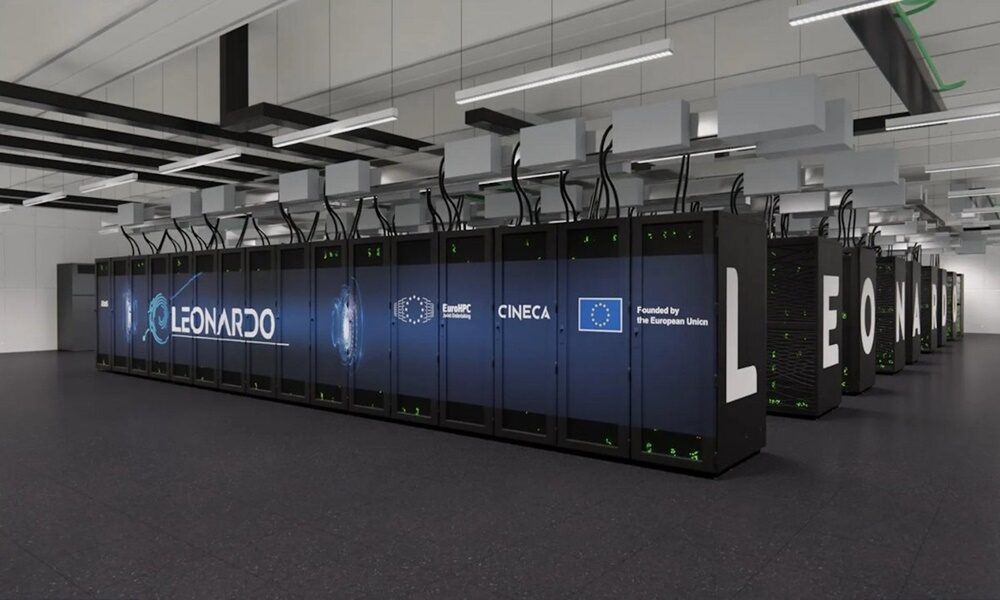
The November 24 It will always be remembered as the day when Europe stepped forward, overtook powers like the United States and Japan on the left and hit the table to show that its investment and technological potential know no limits. That day was the birth of the fourth largest computer in the world; the Leonardo supercomputer.
It is surprising the fact that the Leonardo supercomputer work doing 250,000 trillion calculations per second, which makes it position itself as fourth in the Top 500 ranking, ahead of other technological powers. The first place is occupied by the system frontier of the United States and the second the system fugaku based on ARM from Japan.
You have to remember that the Europe’s first supercomputer it was lumi (third most powerful in the world), which cost about €120 million and has been operating in Finland since last July. The location of the Leonardo supercomputer It is an old tobacco factory in the Technopolis of Bologna (Italy).
The Leonardo supercomputer It is the result of the union between the European Commission, several member countries of the European Union and private companies such as the French computer science Athos and the Italian computer center CINEMA.
Technical characteristics
The work performance of the Leonardo supercomputer is expected to be higher than 249 petaflops when fully operational.
When Atos devised the Leonardo supercomputer it does it taking as reference the architecture BullSequana XH2000. It comprises two essential models of computing: Boosters Y datacentric, which allow covering diverse workloads. The system is equipped with 3,500 Xeon processors and some 14,000 Nvidia GPUs A100.
The Leonardo Supercomputer Booster features 3,456 Intel Ice Like compute nodes, while the Data Centric module consists of 1536 nodes. In turn, the latter is composed of three-node CPU blades BullSequana X2140 with processors Xeon Scalable Sapphire Rapids fourth generation Intel.
Practical applications
The Leonardo supercomputer will allow Europe predict weather phenomena extremes such as tsunamis, earthquakes, hurricanes or volcanic eruptions. In this way, researchers will be able to efficiently manage their risks and solve them before they happen.
In another order, the medicine you will also benefit. The Leonardo supercomputer will help create a map of brain connections and to generate an exhaustive advance in the neuroscience study. In the same way, it will improve medical devices such as pacemakers, solving abnormalities present in the cardiovascular system.
The industrial sector will experience certain improvements in certain sectors such as the automobile, national security, energy or pharmaceuticals thanks to the Leonardo supercomputer. We will also see present Leonardo supercomputer in engineering, modeling of the human brain and in the demanding development of Artificial Intelligence (AI).
The Leonardo supercomputer it will gradually be implemented with the integration of new quantum processors as accelerators. In fact, in 2023 it will join the MareNostrum 5, a pre-exascale computer located at the Barcelona Supercomputing Center. With an investment of €150 millionit will be the fifth or sixth most powerful in the world.
MareNostrum 5 is designed for general purpose computing and AI, so its architecture will be very different from lumi and to Leonardo supercomputer. And later, in the face of 2023 or 2024, Europe is expected to launch the first European exascale supercomputer, the Jupiter.
The tender for Jupiter is not yet available, but it is expected that this system can offer more than 1,000 petaflops when it is operational. It is curious that in 2018 there was no network in Europe and that by 2024 the old continent will have an exascale of power, starting now with the Leonardo supercomputer.
The European Commission will invest 8,000 million euros until 2027 on supercomputers, such as the Leonardo supercomputeralthough it has already launched midrange five (from up to 100 petaflops per secondnamely, 100,000 trillion of operations per second) located in Luxembourg, Portugal, the Czech Republic, Slovenia and Bulgaria.



